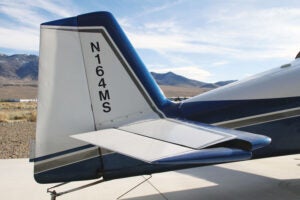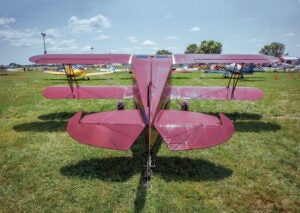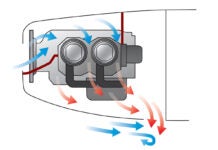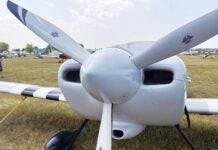
The tail of the airplane performs three functions: It stabilizes the aircraft in both pitch and yaw. It provides trim. It provides control power for the pilot to trim and maneuver the airplane.
Most airplanes have a tail comprised of a horizontal surface (the horizontal tail or stabilizer) and a single vertical fin. This is by far the most common configuration. There are a variety of other tail configurations, and we will discuss those in the future.
Longitudinal (Pitch) Characteristics
Let’s begin by taking a closer look at the horizontal tail. The horizontal tail affects the longitudinal (pitch) characteristics of the airplane. Here are its functions:
Stabilization
The horizontal tail generates moments that stabilize the airplane in pitch. As the angle of attack of the airplane increases, so does the angle of attack of the tail. This increases lift of the tail. Because the tail is aft of the center of gravity, this increase in lift generates a moment that opposes the increase in angle of attack and tends to lower the nose.
The opposite happens when angle of attack decreases. The tail lift moves in a negative direction as the angle of attack of the tail decreases. This generates a nose up change in moment that opposes the change in angle of attack and tends to raise the nose.
The level of stabilization that the tail must provide is a strong function of the overall configuration of the airplane. In particular, the more the center of gravity can move with loading condition and fuel state, the more stabilization the tail will need to provide.
The stabilizing effectiveness of the tail is affected by its area and planform as well as the tail arm. The details of the tail design, particularly of the elevator controls, can also have a large effect on the amount of stabilization the horizontal tail produces.

(Photo: Scott M. Spangler)
Trim
In steady-state flight, the airplane must hold a constant angle of attack and pitch attitude. In order to be in equilibrium and hold this condition, the net pitching moment about the CG must be zero. If there is a net pitching moment, the airplane will pitch either up or down depending on the direction of the net moment.
Every component of the airplane that interacts with the air produces some pitching moment about the center of gravity. These moments vary with flight condition.
The position of the center of gravity of the airplane can also change depending on how the airplane is loaded, and will change somewhat in flight as fuel burns off.
The horizontal tail generates a pitching moment that offsets the moments created by the rest of the airplane and brings the net pitching moment to zero. This is called trimming the airplane. It’s important to note here that trimming the airplane itself, bringing it to a condition of zero pitching moment, is different than what a pilot experiences as trimming the airplane. The two are related but not identical.
The airplane is in trim as long as all of the pitching moments are balanced out. Depending on the details of the trim system and horizontal tail design, this may require some deflection of the elevator. The airplane will be in equilibrium (and hence trimmed) as long as the proper elevator deflection is maintained, regardless of how much stick force the pilot must exert to hold the elevators in the proper position.
It’s possible for the airplane to be in trim with the pilot exerting a steady force on the stick to hold that condition. A pilot who has to hold a constant stick force to keep the airplane in steady-state flight does not experience the airplane as “trimmed” even though all of the forces and moments acting on the airplane itself are in equilibrium.
Most airplanes have a trim system that allows the pilot to adjust the stick force needed to hold any specific flight condition. The pilot uses this to “trim out” the stick force in steady-state flight. For the pilot, the airplane is in trim when it is in steady-state equilibrium in flight and there is no steady-state stick force needed to maintain that condition.
The horizontal tail and the controls associated with it must be able to generate the moment needed to trim the airplane and to also “trim out” stick force to provide the pilot with an in-trim airplane.
Control
In addition to stabilizing and trimming the airplane, the tail is used to control the airplane in pitch. The pilot must be able to command nose-up and nose-down pitch rates and also control and direct the pitch trajectory of the airplane. There must be sufficient pitch control power available for the pilot to trim and maneuver the airplane over the entire flight envelope.
The maximum pitch control power required can be set either by trim considerations or by the need to be able to command a certain pitch rate. In general, there should be some additional control power available at any equilibrium flight condition so the pilot can command the airplane both nose-up and nose-down without the controls hitting a stop.
Trim-related pitch-control power requirements generally arise when the airplane is loaded to its most forward center of gravity. In particular, it is common for the forward CG limit to be set by the ability to trim the airplane to maximum lift with the CG at its forward limit and the flaps down.
Rate-related control power requirements also tend to arise at the edges of the flight envelope. A few airplanes (typically fighters and aerobatic airplanes) have requirements to command specific pitch rates to execute specific maneuvers, but this is rare.
Two very common pitch-rate command requirements are related to takeoff and stall recovery. On takeoff, the pilot of an airplane with tricycle landing gear must be able to command a nose-up pitch to rotate for liftoff and to arrest that pitch rate and capture the proper takeoff attitude and angle of attack. Nose gear liftoff at forward CG in takeoff configuration is a situation that very often defines the maximum control power needed from the horizontal tail. Conversely, the control power available from the tail can set the forward CG limit of the airplane.
At the opposite edge of the flight envelope, the pilot must be able to command a nose-down pitch rate to recover from a stall. For typical single-engine general-aviation airplanes this is not a taxing requirement. Considerable up-elevator is usually needed to stall the airplane, and simply relaxing back pressure on the stick will reduce the angle of attack enough to un-stall the airplane.
This is not the case for every airplane, however. Some airplanes have nonlinear behavior at the stall, and exhibit a nose-up pitching moment shift at high angle of attack. This is a common problem for T-tail and V-tail configurations. Any pitch-up tendency at or near stall is undesirable in and of itself, but if the airplane has this characteristic, it is vital that the tail have enough pitch-control power to drive the nose down from any angle of attack.
Pitch-down recovery from high angles of attack is also a significant concern of modern fighters with full-authority digital flight controls. This type of airplane typically flies with the CG behind the neutral point, making the airplane (deliberately) somewhat unstable in pitch. The flight-control computer compensates for this instability automatically. This setup improves the performance and maneuverability of the airplane, but it also means that as angle of attack increases, the pitching moment about the CG moves steadily more nose-up. The tail must provide enough nose-down pitch control for the pilot to be able to command a nose-down pitch rate at all angles of attack.
Next month we will begin to explore how the configuration of the horizontal tail affects its ability to stabilize, trim and control the airplane.













